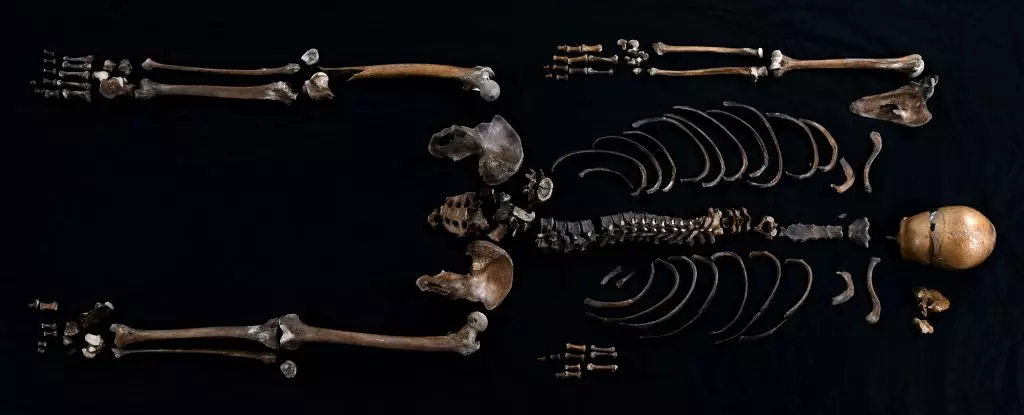The Norse Sverris Saga is an ancient text chronicling the tumultuous reign of King Sverre Sigurdsson, who ruled Norway from 1184 until his demise in 1202 CE. Within its pages lies a chilling account: “They took a dead man and cast him into the well, and then filled it up with stones.” This narrative, a mere footnote concerning the conflict of 1197 CE, has gained unprecedented significance with the discovery of bones attributed to the so-called Well Man. Recent scientific investigations led by a team of researchers from Scandinavia, Iceland, and Ireland have not only given life to this long-forgotten tale but have also revealed tangible evidence linking this individual to the legendary saga.
The ordinary act of throwing a corpse into a well, presumably to taint the water supply, was eclipsed by the broader scope of historical events pertinent to King Sverre’s reign. Yet, with the identification of the Well Man’s remains, this narrative has crystallized into an essential piece of Norway’s medieval history, one of the first documented instances where a legendary figure has been corroborated by actual historical evidence.
The bones of the Well Man were initially discovered in 1938 deep within the confines of the Sverresborg Castle well, located in central Norway. Unfortunately, at the time, the scientific tools required for substantial analysis were rudimentary. However, advancements in genomic analysis have radically transformed our approach to archaeology. A focused research effort spearheaded by genomicist Martin Ellegaard from the Norwegian University of Science and Technology aimed to extract fresh insights from these ancient remains.
The significance of this endeavor is manifold. As Ellegaard notes, “This is the first time that a person described in these historical texts has actually been found.” The implications for history—particularly for the understanding of medieval societies in Europe—are profound. Given the plethora of ancient remains scattered across the continent, the ability to cross-reference legendary accounts with real artifacts creates a compelling narrative that bridges the gap between myth and reality.
Initially, osteological examinations conducted in 2014 indicated that the skeleton belonged to a male aged between 30 and 40 at the time of death. This information laid the groundwork for deeper investigations employing radiocarbon dating, gene sequencing, and isotope analysis. These scientific techniques revealed that the Well Man lived roughly 900 years ago, aligning with the episode chronicled in the saga.
Genomic analysis has also unveiled more striking details about his physical appearance, suggesting he likely had blond or light brown hair and blue eyes. Further, the researchers utilized a comprehensive database of contemporary Norwegian genomes to trace his possible origins to Vest-Agder, a southern region far removed from Trondheim. As genetic data accumulates, it becomes increasingly possible to paint a vivid picture of historical individuals, thereby enhancing our comprehension of the past.
Beyond understanding the Well Man’s identity, isotope analysis has illuminated aspects of his lifestyle. By examining carbon and nitrogen isotopes within the bones, scientists deduced that his diet largely consisted of seafood—a cultural hint at the lifestyle of individuals living along Norway’s coastal areas during the medieval period.
The exact circumstances leading to his death remain shrouded in mystery. Though the saga suggests he was already deceased by the time he was disposed of, it posits that he may have fallen victim during a stealth attack orchestrated by the Baglers, a faction opposing King Sverre. The text recounts that while Sverre was away, the Baglers invaded Sverresborg, pillaging and destroying it in their wake. It is possible that the Well Man was part of either the invading force or the castle’s defenders—a nuanced depiction that contributes to the complex narrative of medieval Norwegian history.
The investigation into the Well Man emphasizes the extraordinary potential that lies in the interconnection of rigorous academic inquiry and historical scholarship. Archaeologist Anna Petersén highlights the complexities of historical narratives, noting, “The text is not absolutely correct… the reality is much more complex than the text.” This collaboration between scientists and historians ultimately provides a more holistic understanding of our past.
The unfolding story of the Well Man serves as a testament to the rich tapestry of history that can emerge when advanced scientific techniques are applied to ancient texts. As we continue to unlock the secrets of the past, we not only resurrect forgotten individuals but also gain insight into the lives and challenges faced by our ancestors, enhancing our connection to the history that shaped our modern existence.


Leave a Reply